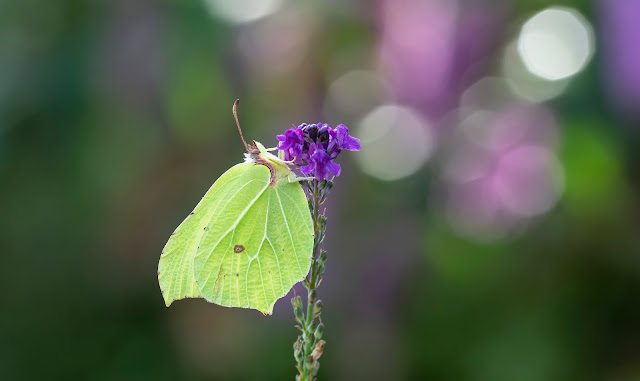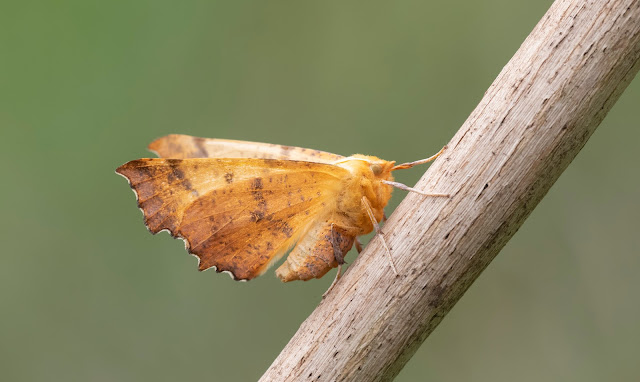It has been a fabulous year for my colony of Lace Border. After carrying out lots of scrub clearance work last winter, helped admirably by Graham, to help open up the area for the Thyme to grow the species has really taken off with my highest ever daily count in recent weeks of 30 individuals. Bearing in mind the total count of this species in Sussex between the 1970s and 2020 was only 5 individuals this is truly astonishing. With the other recently found colony also doing well, that I also monitor, Sussex is suddenly one of the best places in the UK to see this very rare moth.
The beautiful Lace Border.
I was also invited by Dave to go and see his colony of another rare moth, the Oblique Striped, that occurs on private land that he has permission to visit to monitor butterflies and moths. I had only seen one of these moths before, but by the end of the session we had seen around 17 of them as well as an egg laying Six-belted Clearwing and several Hummingbird Hawk-moths.
Oblique Striped.
The late summer has once again produced several of the stunning Wasp Spider. The female of which is a very colourful species. I never tire of seeing this beautiful spider.
%20-%20Copy.jpg)
Female Wasp Spider.
In the garden a month ago I had a lovely male Brimstone go to roost, and as it was there the following morning I had a short session photographing it, before it went back to feeding most of the day on the Buddleia.
Male Brimstone on Purple Toadflax.
I had a private Naturetrek tour with a lady from Yorkshire. She had booked me back in the spring with the request if possible to see the Long-tailed Blue and Clouded Yellow with a further request for the Silver-spotted Skipper. As I had the Butterfly 3 day tour the week before I was confident of showing her the Long-tailed Blue, but the Clouded Yellow was a bit more of a problem as they have been a bit thin on the ground this year, as was the Silver-spotted Skipper, as all the sites I am familiar with would be a problem fitting into the one day. So with a little bit of detective work Lisa and I went to check a couple of possible sites for the Skipper that would be nearer to where I was taking the lady for the other two requests. Not only did we find plenty of the Silver-spotted Skippers, Lisa also found a mating pair that performed very well for us.
On the day with the lady from Yorkshire, I managed to show her 7 Long-tailed Blue, 5 Clouded Yellow and many Silver-spotted Skipper. A very memorable and enjoyable day.
Mating Silver-spotted Skipper.
Large Thorn.
On one memorable day on the patch, I was showing a lady from Natural England the colony of Lace Border, a species that she was studying, when a female Grayling suddenly flew past. This was the first sighting of one on the patch since 2015. The site looks really good for the species, but they have never stuck here, probably getting blown away on the windier days. This female was observed the following day egg laying, so hopefully next year will see some more Grayling in the area.
Female Grayling.
On the same day I also managed a nice photo of the Pyrausta nigrata on Common Centaury.
Pyrausta nigrata on Common Centaury.
Each year, another species that I like to try for is the extremely rare Wart-biter Cricket. Named back in the day when some very odd people thought the cricket could remove warts from your hand!!
Lisa had never seen this creature before, so it was well worth looking for. Not too far away from home is the largest natural UK colony of this wonderful cricket. There are also a couple of other local sites where they have been introduced by Natural England with crickets from the colony we were going to. The weather was not really that good, and after searching for some time I was about to give up when I spotted one. A male that was not quite fully grown. Such a delight seeing one of these crickets again. Afterwards we also saw several Raspberry Clearwing. Another new species for Lisa.
Male Wart-biter.
A couple of weeks ago Lisa and I went to Petworth Park for her to test out her new telephoto lens on the Fallow Deer. I had left my telephoto gear at home, but at the time I was happy just to go and see what we could see. The session started really well with a beautiful example of the fungus Chicken Of The Woods. For this I had the better lens, whilst I used the macro, Lisa had to step further back with her big lens. However, when we came to some deer, she was in a much better position and she got some absolutely stunning photos, making me wish I had taken my telephoto gear too.
Chicken Of The Woods fungi.
At Petworth we did see some Willow Emerald damselflies, and we also saw some more at Ebernoe Common afterwards too. However, I did see and get the photo below on my usual local site for them.
The past few days have been spent locally. At last Small Copper are being seen more regularly. This is often the story with Small Coppers with the 1st brood being few and far between. By the time the 3rd brood are on the wing numbers have built up. This lovely individual was taken on a weekend walk in Friston Forest.
Female Small Copper.
On the same walk I had a quick look in a favoured Willow tree for caterpillars. It was only a couple of minutes into the search when I found this rather smart Poplar Hawk-moth larva.
Poplar Hawk-moth larva.
Butterflies are now beginning to slow right down with many species having now finished for the year. However, there are still some gems about. Flying on a walk I did yesterday were lots of Speckled Wood, Red Admiral and Peacock. I was actually doing my 3rd brood Wall Brown count, which ended up slightly disappointing, although to be fair, I was a week or so too late. I did see 23 as well as a dead one in a spider's web. A couple of Comma's also put on a nice show, including this beauty that I had to stand on tip-toe to photograph. I do sometimes wish I was a few inches taller!!
Comma.



%20-%20Copy.jpg)









Espectaculares fotos y hermosas mariposas. Saludos
ReplyDelete